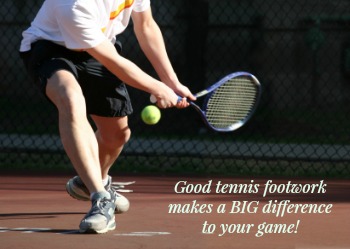Getting Tennis Footwork Like The Pros
There are many tennis “fundamentals” that have articles dedicated to them. The net approach. The forehand grip. How to get topspin on your shots. But before you can do any of that effectively you need to most fundamental building block of them all. Footwork.
There is one
thing that the professionals do better than amateur and semi-pro players
consistently, and this is getting their feet in the right position to play the
shot that they want. Not having the right tennis footwork means you hit your
shot too early, too late, without power or simply put yourself in a position to
not make the shot at all.
With that in
mind we thought a whole article on some basic footwork techniques, as well as a
few more advanced ones would be a great idea to get you to think about your
feet as much as you think about your arm, racquet and groundstrokes.
Ready to go?
The ready
position is the only step that is common to every single shot you will play on
a tennis court. It is the foundation your footwork, and without it, the game
you build will not be as strong.
The reason
to adopt the ready position is that it is the best physiological stance to
attack or defend any shot, by percentage. Think of it as the crouch that a
sprinter takes before taking off for the 100 metres. There are other options,
of course, but none is as efficient or effective for the purpose of being most
ready for the most number of shots.
Your feet
should begin shoulder width apart, or a little wider if you are a shorter
player. Both knees should begin bent, but only at a slight angle. If you bend
too deeply you won’t be able to leverage the power in your legs and spring off
as fast in the direction you want. Also keep in mind that your weight should be
forward, as resting on your heels will also sacrifice crucial reaction time.
A mistake
that a lot of younger players make is having the racquet off to one side, or
hanging next to their hip. The ideal position for your forearms is at 90
degrees to your body and slightly in front, with the racquet in the centre.
Your non-dominant hand should be relaxed on the neck of the racquet ready to
drop off for a one handed shot or slide down to the grip for a two handed
return.
Time to Split
The split
step is the first movement you make, and again, it can be consistently repeated
through most shots. It’s a lot like the slight twitch that a boxer makes as
they dance around the ring. You should only be aiming to get your feet the
slightest distance off the ground. The idea is the same as the sprinters crouch
– to get your body moving as fast as possible. It is much more efficient to do
this from a moving, rather than a standing start.
The ideal
time to execute this move is once your opponent has begun their shot. This is
because predicting where your opponent will hit their shot is a high-risk
strategy, and you need to be able to go in any direction to set up for your
return.
The good
part about this motion is that with sheer repetition and practice you can
improve your reaction time and how well you time your split step. This means
that you gain valuable split seconds on every shot.
One Small Step…
The first
step in the chain after your split step is called the initial movement or first
step. First rotate your body in the direction that you will move then pivot
your back foot and push off it to get your momentum moving in the right
direction.
The ideal
movement mirrors what you are doing with your upper body, in terms of shoulder
rotation and driving toward the ball. A handy way to check is to have someone
video you and see whether your body is moving in sync. A common mistake is the
footwork lagging the shoulder turn, as upper body movement is passive and lower
body movement active for most players.
…And A Few More
A most
common mistake that I saw players doing is side stepping to the ball to hit it.
Obviously the best and fastest way to get to the ball is to run towards it and
prepare your back swing at the same time. Always maintain a good balance before
you hit the shot. For the recovery, if you are not far off from the centre,
side shuffle to the centre and get ready for the next shot. However if you are
near the sideline after hitting the shot, my suggestion is to do a crossover
step and then followed by a few side shuffle steps to go back to the centre.
This is far more efficient then side shuffling all the way from the sideline to
the centre.
These
are just a few of the basic skills that many players do not focus enough on. As
a result, there are weaknesses in many games that can be corrected by
practising and repeating these tennis footwork. Once perfected, you truly have
the foundation for a great tennis game.
You may also like:
Tennis Footwork - A Crucial Part Of The Game
Tennis Footwork: Different Hitting Stances Explained

New! Comments
Have your say about what you just read! Leave me a comment in the box below.